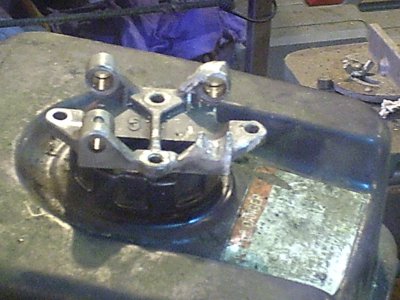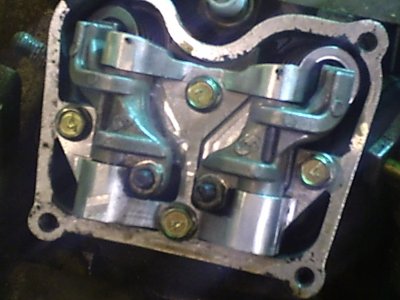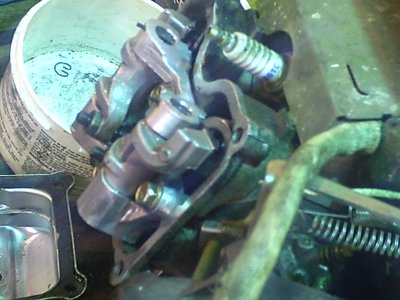- Joined
- Oct 19, 2011
- Messages
- 127
I've been giving some serious thought to converting my mills and lathes over to CNC. I've had 16 years of machinist training and experience in the Navy, but none of it was on CNC machines. I never knew how to use any 3D drawing programs before, but now I'm in college learning AutoCAD in the Drafting Tech program. The gunsmith school I attended after retiring in is now offering CNC training to current and previously graduated students. I'm thinking of taking that class next summer since it's only a month long and would help me piece together all the training I've gotten into something useable. However if I don't use the knowledge, I know it will just go to waste. So on those lines. I'm getting together a plan to convert my machines over to CNC.
There's four machines I have that I'd like to convert over:
1) HF mini mill #44991 (Seig X2 clone)
The X2 clone has had the head counterweight system removed since it always got bound up and wouldn't let me get the full Z axis travel. The X and Y lead screws and dials have been replaced with the "True Inch" kit from Micro Mark. that kit makes each dial revolution = .050 instead of the ridiculous original .0625 per revolution setup. Everything else is stock on it right now.
2) Micro Mark 7x14 mini lathe #82710 (Seig)
The mini lathe has been lapped in, and the rocker tool post was replaced with an A2Z QCTP kit. Everything else on it is stock.
3) Bridgeport Series 1 "J" Head Mill (w/Mitouyo 2 axis DRO)
The Bridgeport will be here tomorrow, so I don't have a lot of first hand details on it yet. It's in good shape and already has a Mintouyo 2 axis DRO installed. I'll just need to level the machine and bolt it down before I can start to make some test parts on it.
4) Atlas 10x54 lathe w/QCGB
The Atlas lathe is completely stock and currently undergoing a (slow) restoration/refurb.
I'd like to convert the two mini machines first since they are both currently fully operational and have already been tuned up a bit. They should be the cheapest to convert as well from what I've seen of of the conversion kits out there for them. The Bridgeport would be next and the Atlas last (after I get it fixed).
As far as computers go, I have a fairly new laptop with AutoCAD 2013 loaded onto it. It's the free educational version, but other than the "Educational version, Not for commercial use." watermark it puts on the drawings, it's exactly the same as the full blown retail version of the program. I know I'll also need some kind of CAM software to convert the drawings to machine tool paths. I've never used any CAM software before though so which one I'll need is still a mystery to me at this point.
Beyond that, I'm not too sure what questions to ask or what parts or specs to look for in a conversion kit. Anyone care to give me a crash course to the basics of getting setup in CNC?
There's four machines I have that I'd like to convert over:
1) HF mini mill #44991 (Seig X2 clone)
The X2 clone has had the head counterweight system removed since it always got bound up and wouldn't let me get the full Z axis travel. The X and Y lead screws and dials have been replaced with the "True Inch" kit from Micro Mark. that kit makes each dial revolution = .050 instead of the ridiculous original .0625 per revolution setup. Everything else is stock on it right now.
2) Micro Mark 7x14 mini lathe #82710 (Seig)
The mini lathe has been lapped in, and the rocker tool post was replaced with an A2Z QCTP kit. Everything else on it is stock.
3) Bridgeport Series 1 "J" Head Mill (w/Mitouyo 2 axis DRO)
The Bridgeport will be here tomorrow, so I don't have a lot of first hand details on it yet. It's in good shape and already has a Mintouyo 2 axis DRO installed. I'll just need to level the machine and bolt it down before I can start to make some test parts on it.
4) Atlas 10x54 lathe w/QCGB
The Atlas lathe is completely stock and currently undergoing a (slow) restoration/refurb.
I'd like to convert the two mini machines first since they are both currently fully operational and have already been tuned up a bit. They should be the cheapest to convert as well from what I've seen of of the conversion kits out there for them. The Bridgeport would be next and the Atlas last (after I get it fixed).
As far as computers go, I have a fairly new laptop with AutoCAD 2013 loaded onto it. It's the free educational version, but other than the "Educational version, Not for commercial use." watermark it puts on the drawings, it's exactly the same as the full blown retail version of the program. I know I'll also need some kind of CAM software to convert the drawings to machine tool paths. I've never used any CAM software before though so which one I'll need is still a mystery to me at this point.
Beyond that, I'm not too sure what questions to ask or what parts or specs to look for in a conversion kit. Anyone care to give me a crash course to the basics of getting setup in CNC?
Last edited:



